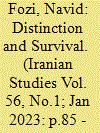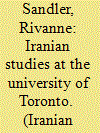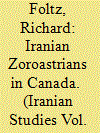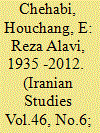|
|
|
Sort Order |
|
|
|
Items / Page
|
|
|
|
|
|
|
| Srl | Item |
| 1 |
ID:
189069


|
|
|
|
|
| Summary/Abstract |
This article argues that the notion of Iranian culture employed in the public discourse of Zoroastrians allows them to tackle the dilemma of Shiʿi-dominated Iranianness without provoking Shiʿi authorities. The piece offers an analysis of ethnographic data, including detailed speech acts documented in Zoroastrians’ ritual spaces and cultural exhibitions. It explores the Zoroastrian configuration of an Iranian culture that summons and encodes pre-Islamic tropes and modern nationalist sentiments by constantly maneuvering around national, religious, and ethnic categories. This configuration's underpinning assumptions, narratives, and texts have powerful platforms in Iranian nationalist imagination. I propose that this arrangement attempts to carve out a space for Zoroastrians’ distinct identity by connecting the history of the Muslim Arab invasion of Persia to the Shiʿi hegemonic norms of Iranian culture today. It further invokes Zoroaster's indigeneity and teachings as the foundation of authentic Iranianness to establish Zoroastrians’ survival as a cultural system.
|
|
|
|
|
|
|
|
|
|
|
|
|
|
|
|
| 2 |
ID:
132104


|
|
|
|
|
| Publication |
2014.
|
| Summary/Abstract |
This article is concerned with ways in which grotesque corporeality shapes Sadeq Chubak's controversial novel The Patient Stone (Sang-e Sabur, 1966). Drawing on Mikhail Bakhtin's understanding of grotesque realism in Rabelais and His World, the discussion demonstrates that Chubak employed devices associated with grotesque aesthetics, and that these devices were used to invert and contest social and literary conventions in Iranian culture, although it seems he remains caught to a certain extent within the very systems he challenges. Grotesque realism involves estrangement of the familiar, and leads to degrading the abstract, spiritual and sublime to the material level of physicality and the body. In The Patient Stone, Chubak replicates motifs of classical Persian epics, religious scriptures and the myth of creation and debases them by excessive depictions of bodily conditions and grotesque corporeality (such as deformity, paralysis and decay). The use of grotesque corporeality embodied in the style, content and characters of Chubak's novel facilitates a variety of paradoxes of being and non-being, appearance and reality, death and rebirth, hope and anxiety of a fragmented and alienated society in desperate need of change.
|
|
|
|
|
|
|
|
|
|
|
|
|
|
|
|
| 3 |
ID:
091290


|
|
|
|
|
| Publication |
2009.
|
| Summary/Abstract |
The International Society for Iranian Studies (ISIS) fortieth anniversary celebration at the University of Toronto provided an opportunity to research and record the development of Iranian studies at the university. Iranian studies emerged in 1961 as a major sub-field of the newly established Department of Islamic Studies (now the Department of Near and Middle Eastern Civilizations (NMC)). Presently, the university has a diverse and yet cohesive cadre of academic talent and offers a breadth of courses, which makes it unique in Canada. The language-based discipline of an earlier generation of scholars has become the present multi-faceted program of today, addressing a wide variety of academic and community interests. The University of Toronto academic tradition, the scholarship of early faculty, and the immigration of Iranians have contributed to shaping Iranian studies in Toronto.
|
|
|
|
|
|
|
|
|
|
|
|
|
|
|
|
| 4 |
ID:
091287


|
|
|
|
|
| Publication |
2009.
|
| Summary/Abstract |
Canada, now the number-one destination for Iranian migrants, is home to one of the world's most dynamic Zoroastrian communities, in which Iranians are increasingly represented and are playing ever more visible roles in maintaining and transforming the tradition. While exile has in some ways reunited Iranian and Parsi (South Asian) Zoroastrians after more than 1,000 years of separation, cultural and in some cases religious differences mean that they continue largely to live in separate spheres even while sharing their places of worship. Iranian Zoroastrians in Canada participate in some social settings as Iranians, in others as Zoroastrians, and in still others as Canadians, but to a large extent they remain a community unto themselves separate from these other three. Even so, their generally progressive interpretations of Zoroastrianism are having an influence on Parsi communities worldwide as well as on Zoroastrians in Iran, and being often recognized as "original Iranians" they are playing important roles in promoting awareness of Iranian culture within the broader community.
|
|
|
|
|
|
|
|
|
|
|
|
|
|
|
|
| 5 |
ID:
124467


|
|
|
|
|
| Publication |
2013.
|
| Summary/Abstract |
Reza Alavi Shooshtari was born in Ahvaz on 7 September 1935. After attending Alborz High School for three years-an experience he did not enjoy because he found the school's ethos too authoritarian-he left Iran in 1950 for the United States and completed his secondary education at the Gilman School in Baltimore, Maryland. He entered Harvard College upon graduation in 1953. A resident of Leverett House, he graduated in 1957 with a concentration in History. Upon his return to Iran in the same year, he studied Persian literature in the traditional manner at Tehran's Sepahsalar Madrasa. In 1959 he went up to Oxford and, as a senior undergraduate at St. Antony's College, read Sanskrit under Thomas Burrow, the Boden Professor of Sanskrit, and R.C. Zaehner, the Spalding Professor of Eastern Religions and Ethics. He held a deep interest in early Buddhism and Upanishadic philosophy, and in the summer of 1960 first visited India to spend some time at an ashram so as to immerse himself practically in Indian philosophy. He received his second BA in Oriental Studies from the University of Oxford in 1962. While at St. Antony's, he also collaborated with Albert Hourani on organizing seminars on Persian literature and history at that college's recently established Middle East Centre. Encouraged by Hourani and Zaehner, he decided to pursue a doctorate at Oxford, for which he was awarded one of the prestigious Boden Scholarships to study Sanskrit and Pali.
|
|
|
|
|
|
|
|
|
|
|
|
|
|
|
|
| 6 |
ID:
124465


|
|
|
|
|
| Publication |
2013.
|
| Summary/Abstract |
The paper consists of six parts. The first part discusses the major reasons for the presence of a conventional sociopolitical Baloch culture in Iran. The second part presents a profile of the Iranian Baloch elites, dividing them into four major groups: the Sunni clerics or molavis, tribal chiefs, the educated, and the wealthy. The third discusses the challenging relationship which exists among the Baloch elites. The fourth describes the elites' attitudes towards the Baloch society's norms. The fifth determines the elites' orientation towards state and politics. And finally the paper ends with conclusions.
|
|
|
|
|
|
|
|
|
|
|
|
|
|
|
|
|
|
|
|
|